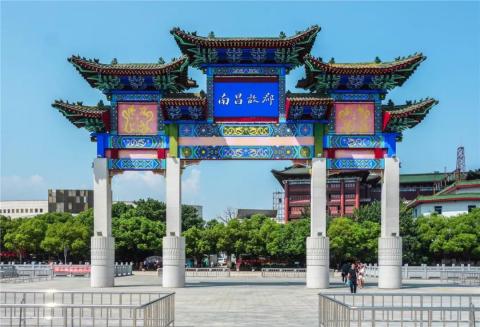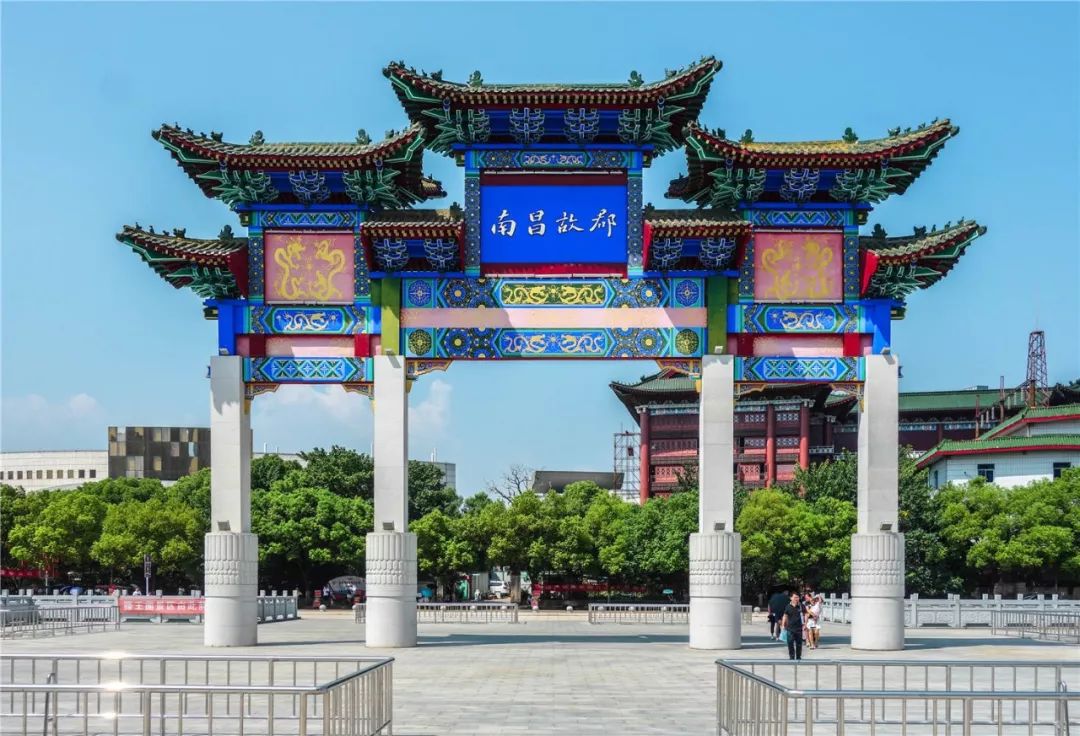
travel plan
Day 1 Shanghai-Nanchang
The next day Nanchang (August 1st Square-Baihuazhou-August 1st Nanchang Uprising Memorial Hall-Jiangxi Provincial Museum-Tengwang Pavilion-Shengjin Pagoda-Qiushui Square)
Day 3 Nanchang-Yingtan(Shangqing Ancient Town-Zhengyiguan-Guyue Water Street)
Day 4 Yingtan-Shanghai (Grand Shangqing Palace-Bamboo Raft-Fairy Rock-Coffin Raising Performance-Mosquito-free Village-Elephant Trunk Mountain-High-altitude Plank Road)
Travel to Nanchang
Since Emperor Taizong of the Tang Dynasty established the Jiangnan West Road, Jiangxi got its name. Wang Bo wrote the "Preface to Prince Teng's Pavilion". From then on, celebrities all over the world yearned for it, and Jiangxi became famous all over the world.
In fact, Jiangxi is a very disadvantaged province. It is said to be close to the Yangtze River Delta Economic Zone, the Pearl River Delta Economic Zone and the West Bank Economic Zone. But from another perspective, it can also be said to be an embarrassing situation of "unreliable". This "dilemma" has indeed left Jiangxi with beautiful scenery that is rarely disturbed by people and unique folk customs.

From Shanghai to Nanchang, you can choose high-speed rail or plane. Flights from Shanghai to Nanchang are often priced as low as less than 200 yuan (mostly early in the morning). However, Nanchang's airport is in the outer suburbs. Taking into account the time to enter the city and security check, it is actually not more convenient than the high-speed rail.
The high-speed trains from Shanghai to Nanchang all depart from Shanghai Hongqiao Station. All trains departing from Shanghai Station are ordinary trains, which take too long. The price of sleeper trains is about the same as that of high-speed trains, so there is no need to choose. There are Nanchang West Station and Nanchang Station to choose from when arriving in Nanchang. Nanchang West Station is in the suburbs. There are many trains and there are subways to the city. There are only two high-speed trains from Hongqiao to Nanchang Station a day, which saves time. Nanchang Station is right in the city and there is a subway, so I chose this high-speed train for this trip.

Live in Nanchang
A city's train station is often the hub of local transportation, and it is also my favorite place to stay when traveling. This is especially true for this Jiangxi trip, because we have to take a train from Nanchang Station to Yingtan early on the third day, so it is naturally more convenient to choose a train station near the train station.
The specific store will not be advertised here. Please make reservations on major websites according to your own financial resources.

night snack
It was already dark when we arrived in Nanchang, and it was already 21:00 after checking in for accommodation. I opened the Dianping APP and searched for a nearby noodle soup restaurant with four-star reviews on Dianping. I originally wanted to just deal with it casually, but unexpectedly it turned out to be the best restaurant in Nanchang.

Nanchang Metro
Nanchang is the capital of Jiangxi Province. The first subway was opened in 2015. Now there are two intersecting subway lines, which can basically reach all major attractions. The subway ticket is such a round bargaining chip. It seems that the Alipay scan code is not available yet, but you can use UnionPay cards with chips. This is very important. Not only can you get a discount, but you also avoid the trouble of queuing up to buy tickets. This saves you at least half an hour when you watch the fountain in Qiushui Square and take the subway. wait.

Bayi Square
Almost every large-scale city has a central square, such as Tiananmen Square in Beijing and People's Square in Shanghai. It is often the geometric center of the city and is also the first scenic spot I am used to visiting.
The center of Nanchang should be this Bayi Square . From the train station, take the subway directly to Bayi Square Station, and you will be in the center of the square when you exit the station.

The August 1st Nanchang Uprising Memorial Tower is a symbol of the square and even the city. The overall shape is somewhat similar to the Monument to the People's Heroes at Tiananmen Square in Beijing, but there is a stone-carved August 1st military flag on the top. The entire memorial hall can be climbed up the stairs to the tower.

The inscription comes from Marshal Ye Jianying's inscription. Directly opposite the memorial tower is a wide square and flagpole. The background of Wanda Plaza is particularly eye-catching. The planning and design is not symmetrical with the central axis of the square, which always feels strange. Perhaps it is a special arrangement based on Feng Shui considerations. As one of the birthplaces of Taoism, Jiangxi always has many strange people and strange things.

On the west side of the square is Jiangxi Provincial Exhibition Center. (Sorry, I can’t tell the difference between east, west and north in Nanchang. It is different from the north-south layout in most cities. Many buildings are oriented east-west, which may be the same as the Ganjiang River. It is related to the direction of the building (Tengwang Pavilion is east-west). The architecture is full of the Soviet style of the 1940s and 1950s. The bright red five-star and yellow main building colors are full of revolutionary atmosphere, making you feel like you have arrived in Pyongyang.

Baihuazhou
"Continent" refers to the land in the water. Nanchang is a land of plenty with dense water network. There is no shortage of water. There are islands scattered all over the water.
Baihuazhou in Bayi Park is probably the most famous one. Compared with Orange Island in Changsha, Baihua Island is really small in size. Its area may be only a few tenths of Orange Island. It is composed of three small islands connected by bridges on the East Lake.

Coming out of Bayi Square, you can reach the Children's Palace building not far along Zhongshan Road, walk into the side entrance of Bayi Park, and cross the Baihua Bridge to reach Baihuazhou.
Looking back at China's modern history, Baihuazhou is probably most famous for having served as Chiang Kai-shek's camp, where he directed the Northern Expedition and the encirclement and suppression of the Red Army.

Nanchang August 1st Uprising Memorial Hall
Continuing along Zhongshan Road, you will reach one of the most important historical sites in Nanchang. It is also the place where the military flag was raised and the place where the Chinese Communist Party achieved victory.

The memorial hall, like all museums and memorial halls across the country, is free to visit by swiping your ID card, and there are several free explanations every day.

After passing the security check, you will see the sculpture "Heroes of a Generation", commemorating the five revolutionary predecessors Zhou Enlai, He Long, Ye Ting, Zhu De, and Liu Bocheng who led the uprising.

First, visit the memorial hall. The first floor introduces the historical background, development process and far-reaching influence of the Nanchang Uprising. Walking up the scenic staircase of "Going to Jinggang", the second floor displays the historical development of the Chinese People's Liberation Army from weak to strong.

The sculpture in the lobby on the first floor is a strong hand stretching out from the cracked stone, clasping the trigger of a Hanyang-made rifle. A stone on the front is engraved with the moment when the uprising started: 2 a.m. on August 1, 1927.

Walking out of the exhibition hall, we can see the former site of the Nanchang Uprising Headquarters, which was the Jiangxi Grand Hotel back then. We can visit every floor to restore the original appearance of history to the maximum extent.

Encounter with Haihunhou
The best window to learn about a city is a museum. However, I went to the Jiangxi Provincial Museum for the sake of Haihunhou.
"A Shocking Discovery—Exhibition of Unearthed Achievements from the Haihun Marquis State of the Han Dynasty in Nanchang" is currently the basic display of the Jiangxi Provincial Museum and the only exhibition currently open.

In 74 BC, Emperor Zhaodi Liu Fuling, son of Emperor Wu of the Han Dynasty, passed away. Since he had no heirs, General Huo Guang supported his nephew Liu He, King of Changyi, as emperor.
Within 27 days of Liu He taking the throne, he did 1,127 ridiculous things and made the palace a mess. After the ministers discussed it, they asked the Queen Mother of Shangguan to issue an edict, and Liu He was deposed that month. Later, Liu He was driven back to Changyi and reduced to a commoner. Within a few years, Liu He almost became a useless person. Emperor Xuan of the Han Dynasty named him Marquis of Haihun, with a settlement of 4,000 households.

